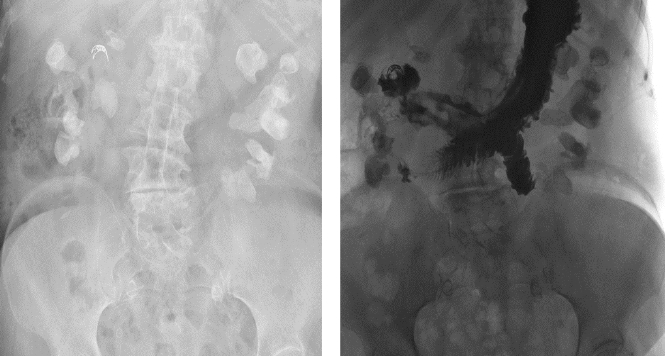Forrest-Klassifikation
Dr. Shannon Melissa Chan
Prince of Wales Hospital, The Chinese University of Hong Kong
Forrest-Klassifikation
Die Forrest Klassifikation wurde zum ersten Mal 1974 von J. A. Forrest et al in der Zeitschrift The Lancet beschrieben. Sie ist eine weit verbreitete Einteilung von ulkus-bedingten Blutungen im oberen Gastrointestinaltrakt. Ursprünglich wurde die Klassi-fikation entwickelt, um die Beschreibung von Ulkusblutungen zu vereinheitlichen und somit die Kommunikation zwischen Untersuchern zu standardisieren. Inzwischen wird die Forrest-Klassifikation jedoch als Instrument zur Identifizierung von Patienten ver-wendet, bei denen ein erhöhtes Risiko für Blutungen, erneute Blutungen und Mortali-tät besteht.
| Forrest Klassifikationen | |
| Zeichen einer akuten Blutung Forrest Ia Forrest Ib | aktive arterielle Blutung Sicker Blutung |
| Zeichen einer kürzlich stattgehabten Blutung Forrest IIa Forrest IIb Forrest IIc | sichtbarer, nicht blutender Gefäßstumpf Blutkoagel Hämatin Reste |
| Läsionen ohne Zeichen einer akuten Blutung Forrest III | Ulkus |
Beispiel-Abbildungen
Zeichen einer akuten Blutung
Forrest Ia: aktive arterielle Blutung


Zeichen einer akuten Blutung
Forrest Ib: Sicker Blutung



Zeichen einer kürzlich stattgehabten Blutung
Forrest IIa: sichtbarer, nicht blutender Gefäßstumpf


Zeichen einer kürzlich stattgehabten Blutung
Forrest IIb: Blutkoagel


Zeichen einer kürzlich stattgehabten Blutung
Forrest IIc: Hämatin Reste


Läsionen ohne Zeichen einer akuten Blutung
Forrest III: Ulkus



Bildnachweis:
u.a. Bilder von Prof. Dr. Benjamin Walter, Uniklinikum Ulm
Literatur:
- Forrest, JA.; Finlayson, ND.; Shearman, DJ. (Aug 1974). ‘Endoscopy in gastrointestinal bleeding’. Lancet. 2 (7877): 394–7.
- Rockall, TA, Logan, RF, Devlin, HB et al. ‘Risk assessment after acute upper gastrointestinal haemorrhage’. Gut 1996; 38: 316–21.
- Guglielmi A, Ruzzenente, A, Sandri, M et al. ‘Risk assessment and prediction of rebleeding in bleeding gastroduodenal ulcer’. Endoscopy 2002; 34: 778–86.


